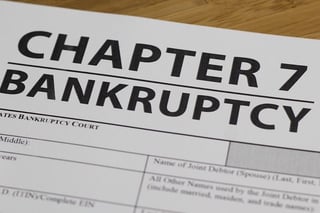chapter 7 no asset process
When there is no non-exempt property in a case, the case is referred to as a “no asset” case. Case trustees are appointed to administer no asset cases, but that administration typically involves reviewing the case and conducting a meeting with the bankruptcy debtor. At that meeting, often called a “341 Meeting” or a “first meeting of creditors” the case trustee asks the bankruptcy debtor a series of questions while the debtor is under oath. The questions are routine; the questions are designed to have the debtor testify that the schedules filed in the case are true and correct. Assuming that the debtor testifies that the information in the bankruptcy papers is indeed true and correct, the case trustee will file something called a "no asset report" with the court. The debtor then receive his discharge 60 days after the meeting with the bankruptcy trustee.
What happens in a chapter 7 asset case
Occasionally, a chapter 7 debtor will file a case in which there are non-exempt property. When the case is filed, the debtor notes in the bankruptcy petition that the debtor believes there are assets available for administration by the trustee. When this happens, the debtor, who has been holding all of the property she owns in trust for creditors, must cooperate with the trustee to either turn over the asset or to purchase the asset back from the trustee.
what are considered assets in chapter 7
Typically, Chapter 7 cases have assets available for administration when the debtors have significant equity in their home. When that is the case, there are a number of commonly-held properties that are typically turned over, including cash on hand or in the bank, “extra” vehicles, recreational vehicles and equipment and non-homestead real estate holdings.
denial of discharge chapter 7
Failure to either purchase non-exempt assets back from the property of the estate, or turn them over to the case trustee can result in the trustee asking the bankruptcy court to order a turnover of the asset(s), and failure to comply with that order can trigger a lawsuit from the trustee asking the court to deny a discharge to the debtor, or, if the debtor has already been entered, to revoke that discharge. Since the reason to file a bankruptcy case is to get debts discharged, it is clear that cooperating with the trustee in an asset case is critical.
The 341 meeting of creditors
Chapter 7 debtors must attend a meeting with the case trustee - this is called “the first meeting of creditors” or “the 341 meeting” (named after section 341 of the bankruptcy code, which mandates that this meeting take place.)
entry of an order for relief
The notice - the order for relief - that is sent to all listed creditors, the debtor and the debtor’s attorney at the time the case is filed will contain the name and address of the case trustee appointed on the case and the date, time and location of the meeting. Typically the meeting will be scheduled more than 21 days after the case is filed but not more than 42 days after the case is filed. By law, the bankruptcy judge who has jurisdiction over the case cannot attend this meeting.
do creditors show up at 341 meeting
In most consumer bankruptcy cases, creditor do not attend the 341 meeting, although they have a right to do so. Creditors will sometimes appear at the meeting if the creditor has a security interest in property owned by the debtor and the creditor is concerned that the value of the property has been unduly depreciated, or in cases where creditors believe that the debtor has not been honest in dealing with the creditor in the debt transaction. The attraction for creditors in such cases is that the debtor is required to testify under oath at the meeting; so in cases where the creditor suspects the debtor has not been honest, the creditor has the ability to depose the debtor at a relatively low cost. Creditors in these situations are limited to questioning the debtor about assets and liabilities - questions such as “why did you do this?’ or “do you know how much money you cost me?” are outside of that scope and, thus, objectionable. But typically creditors do not attend the meeting - and that means that the trustee is the only person questioning the debtor.
what questions Can Be Asked in a 341 meeting
The questions the trustee asks in almost every case are routine and designed to make sure the debtor is familiar with the information contained in the bankruptcy petition and schedules filed with the court, that the information is true and correct, and whether there are non-exempt assets of the bankruptcy estate, and/or whether there has been financial transactions, such as preferential payments to 3rd party creditors or related parties, or transfers of money or property to close friends or relatives, that can result in the trustee liquidating assets or voiding transactions. The meeting will usually take about five to ten minutes to complete. After the meeting is concluded, the next legal step is for the debtor to receive a bankruptcy discharge.
341 meeting experiences
Additional Information...
• What Is Chapter 7 Bankruptcy And How It Works
• 4 Good Reasons To File Chapter 13 vs. Chapter 7


 After filing any bankruptcy you could be face with a variety of legal, financial and/or emotional consequences. Sometimes good, sometimes bad. Regardless, let's start by taking a look at the legal outcomes of filing
After filing any bankruptcy you could be face with a variety of legal, financial and/or emotional consequences. Sometimes good, sometimes bad. Regardless, let's start by taking a look at the legal outcomes of filing 